


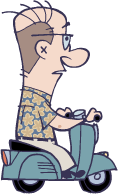




It’s hard to believe some people don’t believe counter-steering is a real thing. This despite the century or so of motorcycle racers doing it. For those readers unfamiliar with counter-steering, it is sometimes stated as, “Turn right to go left.” It might sound absurd, but it works.
The first thing we need to clear up is that counter-steering is not really about turning so much as about leaning and balance. Which means “turn right to go left” is misleading though accurate. I’ll explain that in a bit.
If you read my article “Bikes Don’t Turn by Leaning” (link below) you know why leaning a bike can’t possibly make it turn. The reverse is completely contrary, turning a bike will make it lean. Which might sound somewhat inconsistant until you think about it for a minute.
Ask yourself, why do you lean left when you turn left? So you don’t fall over to the right, to the outside of the turn. Why would you fall over to the right? Because you’re turning left. In other words, turning a bike will make it lean. See, I told you you only had to think about it for a minute.
A Little Physics: A turning bike (or a turning anything) is displaying circular motion. Circular motion is created by combining forward momentum with a centripetal force, a force applied at a right angle to the direction of momentum. Circular motion results in a centrifugal effect, or counter-force directly opposed to the centripetal force.
With the above in mind it’s easy to understand why turning a bike left would make it fall over to the right, the resulting centrifugal effect. Counter-steering is all about using this bit of basic physics to your advantage rather than to your detriment. That is, to lean into the turn rather than fall over to the outside of the turn.
This is pretty much the procedure for a left turn: As you approach the turn rotate your handlebars right. The bike starts turning right. Circular motion creates a centrifugal effect rolling the bike left, which is the way you wanted to turn. After rolling left you then turn left.
One misconception about counter-steering is you continue turning against the turn all the time. No, no, no. Your initial opposite turn initiates the roll into the turn. Then you absolutely must turn into the turn. Or at least you’d better if you don’t want to crash.
Below left to right: Rider rides straight, momentum (A) is straight ahead. At start of turn, right front end rotation puts a centripetal force (B) on contact patch to the right. Combined with momentum this creates a centrifugal effect (C) to the left, which combined with gravity rolls the bike left. After rolling left, front end then rotates left and bike starts going left. This reverses the centripetal force (B) to the left and the resulting centrifugal effect (C) to the right, which is countered by gravity (not shown, but you know) as bike is already rolled left thus maintaining tilt through the turn. In other words, you don’t fall inward.

If you follow the track of the front wheel, it goes quickly right then left. You might call it double-turning instead, though most everyone else will still call it counter-steering even though I think double-turning is more accurate.
In a way the phrase “turn right to go left” is misleading because in the end the front wheel must rotate left to turn left. So really you turn right to roll left and then turn left to go left. But that’s not very short and sweet and probably rather confusing. This technique works going fast or slow, for big or small turns, for wide or sharp turns. It’s fairly simple and straight-forward physics.
That’s really all there is to it. It’s all turning by tracking and the physics of circular motion. There is absolutely no turning from so-called cone effects or precession from wheels being gyroscopes. The previously mentioned article Bikes Don’t Turn by Leaning explains and demonstrates how these two common notions are wrong.
Thing is, bike riders counter-steer all the time without realizing it. For instance when riding straight ahead we constantly make little tiny turns of the front wheel to stay balanced. Check out the tracks left behind after you ride through a puddle. The front wheel track weaves back and forth a bit, the rear wheel track is pretty straight right in the middle.

The faster you’re going the greater the centrifugal effect, so the less you need to turn the front wheel to maintain balance. At slow speed there’s a lot less centrifugal effect and so you need bigger turning adjustments to maintain balance. That’s why you wobble a lot more at very slow speed. In the end it’s easier to stay balanced with speed because you need smaller adjustments of the front wheel. All that is counter-steering, balancing a bike by turning.
The quicker and greater you initially rotate the front wheel against the turn to counter-steer the quicker and more you will lean into the turn. This is why motorcycle racers do it. At high speed you don’t want to gradually lean in, you want to do it fast. The faster the better. It also works for non-racers in an emergency to make a very quick, sharp turn out of trouble. Practice it, it might come in handy. It could even save your life.
Simple physics explains bike stability at speed, it takes less turning the faster you go to create centrifugal effect to stop falling over. Less turning means a straighter path with less wobble which feels just like more stability. Pretty simple, really. Though I would say the bike isn’t really more stabile, it’s just easier for the rider to stabilize. The real key is the rider. People have the strength and agility to ride bikes of all kinds and keep them balanced with a little practice.
Still, some like the scientific sounding idea that wheels being gyroscopes help you maintain stability and balance. Unfortunately it doesn’t work that way. Richard Klein, at the University of Illinois built bikes with counter-rotating wheels that completely cancel any gyroscopic effect and the bike’s stability was unchanged.
I think some folks greatly overestimate the power and effect of a spinning wheel on a bike as a gyroscope. It really is quite small and meaningless for practical purposes.
The question is not how wheels behave because they’re gyroscopes, but how gyroscopes behave when they’re wheels. A wheel rolling on the ground tilts over at the contact patch and not the center of the wheel. This different motion means the rotational torque is weaker in comparison.
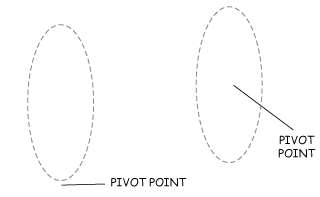


Mouseover pic to compare
Many of us have played with spinning bicycle wheels in our hands to see the gyroscopic effect and it feels pretty strong. But that’s from turning it at the center of rotation and not pivoting it from the bottom, which is how a bike does it. At any rate, the axis of tilt rotation of a wheel rolling on the ground is at the contact patch and not the center of the wheel. This makes a difference.
I did comparative measurements of the torque generated by each using a fisherman’s spring scale. The method was crude, but the comparison shows the rough difference. I built a device to hold a wheel upright as shown. When I tilted the rig to any angle with the wheel spinning as fast as I could muster by hand, the pull I got with the tilt axis at the center of the wheel was between 6 and 8 pounds. When I did the same with the tilt axis at the bottom of the wheel the pull was 2 to 3 pounds.
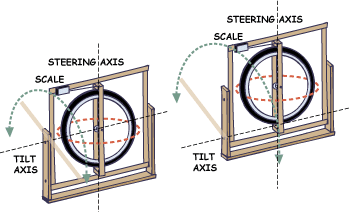
Next, imagine a long lever attached on the steering axis just above the wheel, a set of handlebars. Using that turn the wheel pulling on the spring scale. You can well imagine you’ll get a lot more force than 2 to 3 pounds. If you’ve ever used a torque wrench you know you can get hundreds of foot pounds with your arm strength when multiplied by such a lever. Which means the rider can overpower the gyroscopic torque and negate its effect. After all, if the gyroscopic torque doesn’t turn the front wheel it doesn’t effect the direction the bike takes.
Some people like to tell you counter-steering works by gyroscopic action of the turning front wheel rolling your bike. Well, some people would be mistaken. Consider this, one revolution of the wheel rotates five pounds of wheel one circumference. At the same time one revolution of the wheel moves the entire bike and rider forward the distance of one circumference.
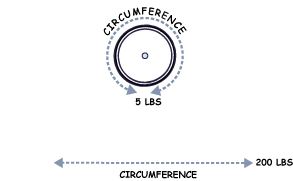



Which amount of momentum do you think has the real effect moving one circumference in the same amount of time, five pounds of wheel or 200 pounds of bike and rider? It doesn’t matter how fast you’re going because the speed of both increase or decrease at the same rate all the time. The total weight of the bike and rider is always more than the front wheel. Plus the wheel rolls from the contact patch so you get less effect than you might suppose.
To compare, and keep gravity from mucking up the proceedings, I altered my rig so the steering axis was horizontal. This way by turning the spinning wheel any gyroscopic effect would make it swung like a gate pulling on an attached fisherman’s scale. I spun the wheel as fast as I could by hand and gave it a turning rotation. It pulled on the scale at one to two pounds.
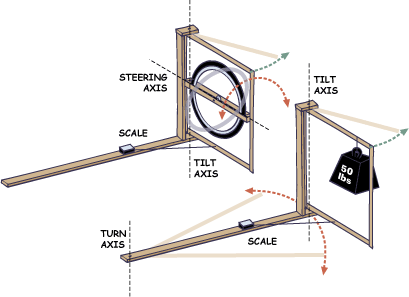
To test the centrifugal force I swung the entire rig, pivoting at a point seven feet from the wheel with a 50 pound weight added on. A small rider, but a tight turn, too. Pushing this along at a walk I got about a 15 to 20 pound reading on the scale. Not the most controlled test, but the best I could do. Anyway, as far as I can determine, the centrifugal effect is much stronger than the gyroscopic effect.
One last point, handlebars are levers that multiply a rider’s turning effort on the front end assembly keeping the rider in control. If other forces, like precession or trail, were stronger, a rider couldn’t steer. Once again it all boils down to the rider being in control and not at the mercy of gyroscopes or trail effects. That’s it. Let’s go riding. And remember, whether counter-steering or going straight, you’re the boss.
© Terry Colon, 2015
Bikes Don’t Turn by Leaning companion article